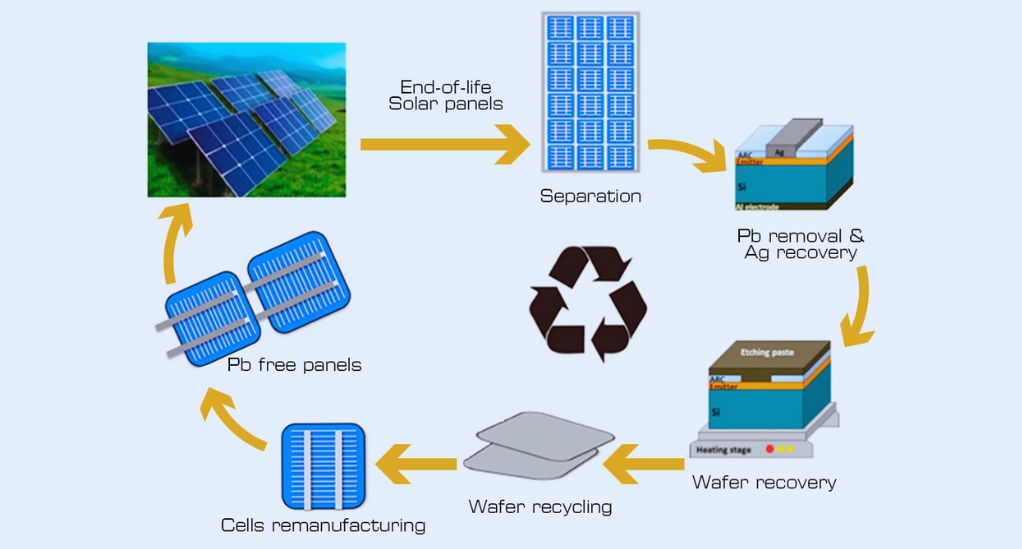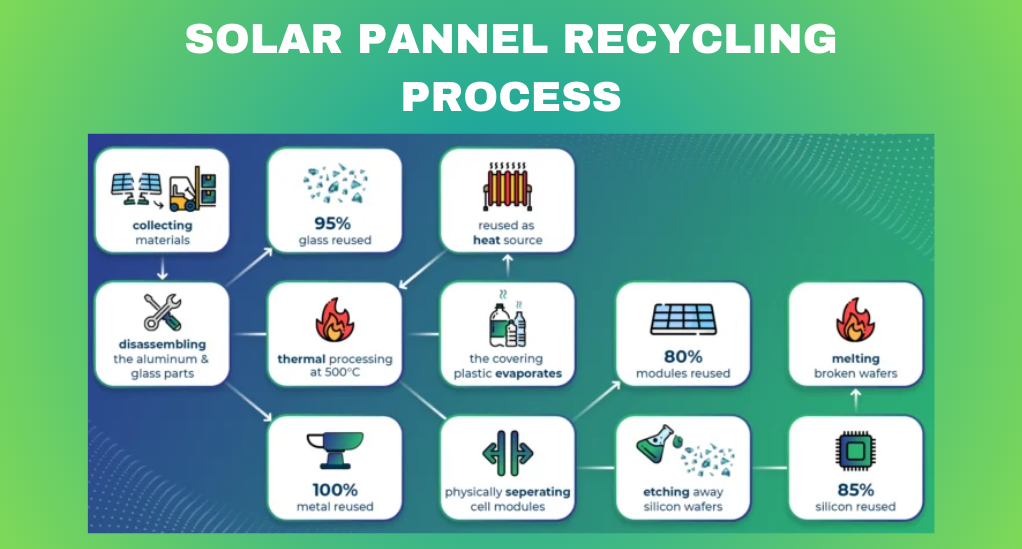Introduction: The Rising Sun of Solar Energy
As the world gravitates towards sustainable energy sources, solar panels stand at the forefront of this revolution, harnessing the power of the sun to generate electricity. This article embarks on an enlightening journey through the lifecycle of a solar panel, from its inception in the manufacturing phase to its final destination in the realm of recycling. This odyssey not only illuminates the technical aspects of solar panel production and usage but also sheds light on the innovative recycling processes that close the loop in their lifecycle, emphasizing the critical role of sustainability in the energy sector.
The importance of solar energy cannot be overstated. It represents a clean, renewable source that significantly reduces our carbon footprint, making it a key player in the battle against climate change. The sun’s abundant energy, harnessed through solar panels, offers a promising solution to the world’s growing energy demands. However, the journey of a solar panel is intricate and multifaceted. It encompasses complex manufacturing processes, efficient energy conversion during its use, and eventually, leads to pioneering recycling methods that ensure environmental stewardship.

The Advent of Solar Panel Manufacturing
The lifecycle of a solar panel begins in the realm of manufacturing, a stage as crucial as it is complex. This phase involves several key steps:
- Design and Raw Material Sourcing: The production process starts with the design of the solar module and the sourcing of raw materials. Essential materials like silicon, aluminum, copper, and glass are procured, often involving considerable energy, especially in the extraction and transportation of these resources.
- Material Processing: Once gathered, these materials undergo processing. For instance, silicon, a primary component in most solar panels, requires purification and conversion into usable forms, a process that is energy-intensive but vital for efficient solar cell functioning.
- Module Assembly: The processed materials are then assembled into solar panels. This step includes embedding silicon cells into frames, wiring, and adding protective layers to ensure durability and efficiency.
- Energy Consumption and Carbon Footprint: It’s crucial to acknowledge that manufacturing solar panels isn’t free from environmental impact. Energy consumption and the resulting carbon footprint during this stage are significant. However, efforts are constantly being made to optimize energy use and enhance efficiency. This is evidenced by initiatives like Trina Solar’s, which achieved “zero” carbon emissions in its manufacturing operations and R&D activities in 2018.
- Technological Advancements: Continuous advancements in technology are making solar panel production more sustainable. Innovations in material efficiency and energy use in manufacturing processes are pivotal in reducing the overall environmental impact.
By understanding these complexities, we can appreciate the intricate balance between harnessing renewable energy and the responsibilities entailed in the production of the technology that enables it. As we delve deeper into the lifecycle of a solar panel, it becomes increasingly clear that every stage – from production to recycling – plays a vital role in shaping a sustainable future.
This introduction provides a comprehensive overview of the beginning stages of a solar panel’s life, setting the stage for further exploration of its use and eventual recycling. The journey of a solar panel is a testament to human ingenuity and our commitment to a sustainable future. As we proceed, we’ll uncover more about how these remarkable devices transform sunlight into energy and the innovative ways in which they can be recycled, thus contributing to a greener planet.
Harnessing the Sun: Usage and Efficiency
After emerging from the production lines, solar panels embark on their primary mission: converting sunlight into electrical energy. This phase is marked by high efficiency and longevity, highlighting the true value of solar technology.
The Energy Payback Time
One of the critical factors in assessing the performance of solar panels is the ‘Energy Payback Time’ (EPT). This term refers to the duration it takes for a solar panel to generate the amount of energy that was used in its production. Depending on various factors like geographic location and technology, the EPT generally ranges between six months to two years. Once this threshold is crossed, the solar panel effectively starts to offset its initial carbon footprint, contributing positively to the environment.
Lifespan and Performance
Solar panels are renowned for their durability, typically coming with warranties of 25 to 30 years. However, they don’t cease to function after this period. Instead, they continue to generate power at a slightly reduced efficiency due to degradation. Factors such as exposure to UV rays and temperature fluctuations gradually reduce their efficiency, but modern solar panels are designed to endure these challenges, ensuring stable performance over their lifetime.
The Environmental Footprint: Life Cycle Analysis
Life Cycle Analysis (LCA) provides a comprehensive view of the environmental impact of solar panels from cradle to grave. This methodology encompasses the entire lifespan, including raw material acquisition, manufacturing, usage, and disposal or recycling. LCA helps in identifying the most environmentally friendly manufacturing, construction, and recycling processes.
Key Factors in LCA
- Raw Materials: The acquisition and transportation of raw materials like aluminum, copper, and silicon contribute significantly to the overall environmental footprint.
- Manufacturing Process: Energy consumption during the manufacturing stage, while necessary, adds to the carbon footprint.
- Usage: The operational phase offsets the energy used during production and continues to provide renewable energy.
- End-of-Life: The disposal and recycling process, essential for minimizing environmental impact, concludes the life cycle.
The Decline: Degradation and Longevity
Despite their resilience, solar panels do experience degradation over time. This section delves into the factors affecting their long-term performance and how technology aims to mitigate these effects.
Degradation Rates
- UV Exposure: Constant exposure to sunlight, ironically, contributes to the slow degradation of solar panels.
- Environmental Stress: Fluctuations in temperature and other environmental factors also play a role in reducing efficiency.
However, with advanced engineering, modern solar panels are designed to minimize these effects, ensuring that their efficiency drops only marginally over decades of use.
End-of-Life Strategies: Recycling and Disposal
As solar panels reach the end of their effective life, the focus shifts to responsible disposal and recycling. This stage is crucial for maintaining the sustainability cycle of solar energy.

Recycling Processes
Solar panel recycling involves several key steps:
- Disassembly: Separating valuable materials like glass, aluminum, and silicon cells.
- Shredding and Separation: Breaking down the panels into smaller fragments for more efficient separation of materials.
- Material Recovery: Extracting and purifying materials for reuse in new solar panels or other products.
Advanced methods, such as robotic deconstruction and nanotechnology, are being developed to enhance the efficiency and effectiveness of the recycling process.
Disposal Regulations
The disposal of solar panels is governed by stringent regulations designed to minimize environmental harm. These regulations mandate proper recycling methods and waste management practices, ensuring that solar panels continue to benefit the environment even at the end of their lifecycle.
Conclusion
The lifecycle of a solar panel is a remarkable narrative of technological advancement and environmental stewardship. From the energy-intensive production phase to the efficient conversion of sunlight into electricity, and finally to the responsible recycling and disposal, each stage plays a vital role in shaping our sustainable energy future. As the renewable energy sector continues to evolve, ongoing research and innovation in solar panel technology and recycling methods will be crucial in ensuring a greener, cleaner planet for future generations.
This comprehensive exploration of the solar panel lifecycle not only informs but also inspires a deeper appreciation for this incredible technology. As we harness the power of the sun, we are reminded of our responsibility to manage these resources wisely, ensuring a sustainable legacy for the world.
